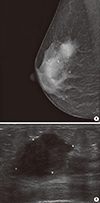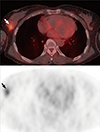Abstract
Nongestational choriocarcinoma differentiation is extremely rare in breast neoplasms. It is characterized by tumor cells similar to chorionic trophoblastic cells, which react with human placental lactogen and human chorionic gonadotropin (hCG). A 56-year-old woman presented with a palpable right breast mass without past history of trophoblastic tumors. An F-18 fluorodeoxyglucose (FDG) positron emission tomography/computed tomography (PET/CT) scan revealed one focus with low accumulation of FDG in the right breast (maximum standardized uptake value, 1.98). The patient underwent a right mastectomy and biopsy of sentinel nodes. Microscopically, the tumor was a typical invasive ductal carcinoma with multiple foci of choriocarcinoma features. Immunohistochemistry showed that the tumor cells resembling choriocarcinoma were positive for hCG antibody, but negative for HER2/neu, estrogen receptor, and progesterone receptor. A pathologic diagnosis of breast carcinoma with choriocarcinomatous features was made. To our knowledge, this is the first report of invasive carcinoma with choriocarcinomatous features and an unusual finding of low accumulation in an F-18 FDG PET/CT scan in Korea.
Breast carcinoma can produce hormonal products including human placental lactogen (hPL), adrenocorticotropic hormone, and norepinephrine [1-3]. Human chorionic gonadotropin (hCG) is also found in the blood in 12% to 33% of patients with breast carcinoma. However, the majority of these tumors do not show choriocarcinomatous differentiation [2,4]. In addition, isolated tumor cells immunoreactive to hCG antibody are found in about 5% to 21% of ordinary invasive ductal carcinomas without choriocarcinomatous differentiation [2,4]. Occasional nonchoriocarcinomatous cells reactive to hCG antibodies may be present, but have to prognostic significance or functional effects [2,4]. Carcinomas with choriocarcinoma features (BCCF) are a distinct variant of breast carcinoma, and were described for the first time in the literature in 1981 by Saigo and Rosen [5]. These tumors are characterized by highly pleomorphic tumor cells similar to choriocarcinoma cells admixed with a malignant epithelial component. Immunohistochemistry (IHC) shows that these tumor cells also express serum hCG and hCG antibodies.
A 56-year-old woman presented with a palpable mass in the upper outer quadrant of the right breast. She had no previous history of hydatidiform moles or choriocarcinoma. Following the first radiological studies that included mammography and ultrasonography (Figure 1), she was referred for staging using F-18 fluorodeoxyglucose (FDG) positron emission tomography/computed tomography (PET/CT). This scan showed a soft tissue mass with low accumulation of FDG with a maximum standardized uptake value (maxSUV) of 1.98 in the right breast (Figure 2). No other hypermetabolic lesion was detected in the body. Clinically, the F-18 FDG PET/CT scan revealed malignancy in the right breast. The patient underwent a right mastectomy and a biopsy of sentinel nodes. The resected tumor was 2.4 cm in diameter with relatively well-defined irregular margins (Figure 3). The cut surface was partially hemorrhagic and mostly gray to whitish-in color. Microscopically, the tumor was a typical high-grade invasive ductal carcinoma with multiple foci of choriocarcinomatous features without any other metaplastic squamous or spindle cell components (Figure 4). The choriocarcinomatous lesion contained highly pleomorphic tumor cells with an increased nucleus-cytoplasmic ratio, prominent nucleoli, and syncytiotrophoblast-like multinucleated giant cells. The area of choriocarcinomatous differentiation comprised approximaterly 25% of the entire invasive carcinoma. Immunohistochemically, only the choriocarcinoma-resembling tumor cells were reactive for the hCG antibody (Figure 4), but negative for HER2/neu, estrogen receptor (ER), and progesterone receptor (PR). Fifty percent of the tumor cells were reactive for the Ki-67 antibody. A diagnosis of BCCF was confirmed based on IHC and histological phenotype results. The postoperative serum β-hCG level (3.18 mIU/mL) was not increased significantly, while the 4 sentinel nodes showed no metastatic deposits.
Choriocarcinomas in the breast are rare and represent less than 10% of all gynecological malignancies. Metastatic choriocarcinoma occurs in about 4% of patients with hydatidiform moles and very rarely after term pregnancies or abortions (1 in 40,000) [6]. The breast is an uncommon site for choriocarcinoma metastasis.
Choriocarcinomatous features are observed rarely in breast carcinoma, and need to be differentiated from metastatic choriocarcinoma. The first report of BCCF was published in 1981 by Saigo and Rosen [5]. This was an unusual case report of a breast carcinoma in a 55-year-old woman. Grossly, the 2.5-cm tumor was partially hemorrhagic and consisted of areas of invasive ductal carcinoma admixed with areas very similar to choriocarcinoma [7].
In a few unusual instances, the microscopic growth pattern of breast carcinoma simulates a nonmammary neoplasm by often containing ectopic hormones, resulting in similar-biochemical and structural phenotypes. BCCF is a striking example of this phenomenon. Choriocarcinomatous features have also been observed in association with adenocarcinoma in a variety of gastrointestinal tumors, especially in the stomach, jejunum, colon, and esophagus [8].
To date, only a few cases of BCCF have been reported. Erhan et al. [2] and Hamati et al. [6] described the clinical, pathological and IHC features of 7 cases of BCCF. Table 1 summarizes the clinical characteristics of these cases, including age, stages, treatment modalities, and survival data. The median age at the time of diagnosis was 53.5 years (range, 48-59 years). The majority of tumors were located in the right breast and had a median size of 4.3 cm. Most patients had metastasis in the axillary lymph nodes, and all cases were positive for hCG antibody in IHC studies. The majority of patients had invasive ductal carcinoma or another subtype of breast carcinoma with peripheral choriocarcinomatous lesions [9]. Two patients were treated by modified radical mastectomy and axillary lymph node dissection, while 1 patient underwent a partial mastectomy with lymph node dissection.
Although increased levels of serum hCG is a common finding in patients with breast carcinoma, the actual pathophysiological role and clinical significance of hCG expression in these tumors remains unclear. Resetkova et al. [9] suggested that hCG may have a role in the synthesis and secretion of estrogen and progesterone. Increased serum levels of hCG and immunoreactivity to hCG antibody in the tumor tissue are rare findings in patients with breast carcinoma. These findings suggest metastatic choriocarcinoma in the breast or BCCF. The cytopathological characteristics of choriocarcinomatous breast cancers are similar to those of choriocarcinomas of the genital tract. It is important that BCCF is distinguished from metastatic choriocarcinoma of the breast [2,6]. Metastatic choriocarcinomas of the breast are also extremely rare, and only a few cases have been reported in the literature. In contrast to BCCF, the majority of these patients are pregnant, have previously been pregnant, or have a past history of hydatidiform moles or choriocarcinoma [1].
A review of BCCF cases shows that choriocarcinomatous lesions are associated with invasive ductal carcinoma or ductal carcinoma in situ. IHC reactivity for hCG antibody and no gynecological history are essential features for a correct diagnosis. Pathological studies on complete excisional biopsies are, therefore, necessary to make a correct diagnosis, and to classify the carcinoma subtype.
The histogenetic origin of syncytiotrophoblast-like multinucleated giant cells seen in BCCF is unknown. The most reliable theory of BCCF histogenesis involves a metaplastic process. The fact that breast tumors frequently show metaplastic changes such as squamous, spindle cells, or osseous, chondroid, or matrix production is evidence for this process [2,5]. According to the World Health Organization classification of breast tumors, BCCF represents a distinct variant of invasive carcinoma of no special type, and is not classified as a common metaplastic carcinoma.
BCCF show aggressive behavior in the majority of cases with many patients presenting with lymph node and distant metastases. Only a few cases have a favorable outcome [2,9]. Currently, treatment for BCCF involves surgical resection similar to that performed for other breast carcinomas. Because BCCF is a rare tumor, the best chemotherapeutic modality for treating the disease has yet to be established, with previously reported cases showing a poor response to chemotherapy [2,9]. Although choriocarcinoma is an aggressive and widely metastasizing tumor, in comparison with BCCF, it responds well to chemotherapy and sometimes surgery can be avoided. It is therefore extremely important to make an early diagnosis of BCCF and to initiate appropriate treatment protocols.
F-18 FDG PET is a versatile tool for detecting malignant tissue, as a accumulation of FDG is increased by the higher rate of glycolysis in malignant cells [10]. Breast choriocarcinoma detected by F-18 FDG PET/CT has not been reported. Previously, although several reports has described FDG accumulation in lung metastasis from choriocarcinomas [11]. In contrast, a few cases have shown low FDG accumulation in choriocarcinoma lesions [12]. Although these case reports did not discuss specific reasons for why the nodules had low or absent FDG accumulation, hemorrhagic and/or necrotic components of the tumor may have possibly affected FDG avidity. In our case, the tumor mass contained necrotic and hemorrhagic tissues, with cytotrophoblasts and syncytiotrophoblasts forming only a small part (about 25%) of the lesion. This finding may account for the low FDG accumulation that we observed. We therefore assume that the low SUV of the choriocarcinoma lesion was attributable to the small number of tumor cells. To our knowledge, this is the first case showing that F-18 FDG PET/CT may be useful for the detection of BCCF.
In conclusion, BCCF is extremely rare, with only a few cases reported in the literature. To our knowledge, this is the first case of BCCF in Korean patient. It is also the first reported case of detection of a BCCF using F-18 FDG PET/CT. Further evaluation of the nature and histogenetic behavior of BCCF cases is required to establish more effective treatment modalities.
Figures and Tables
Figure 1
Breast imagings. (A) Mammography shows ill-defined lobulating and spiculated mass with microcalcification, classified as category 4. (B) Ultrasonography shows about 3×18 mm lobulating hypoechoic mass in 10 o'clock direction of the right breast.

Figure 2
F-18 fluorodeoxyglucose (FDG) positron emission tomography/computed tomography shows a soft tissue mass lesion with low FDG accumulation with maximum standardized uptake value 1.98 in the right breast (arrow) without other hypermetabolic lesion in whole body.

Figure 4
Characteristic microscopic findings. The carcinoma with choriocarcinomatous features show high nucleus/cytoplasm ratio, increased nuclear chromatin and multinucleated giant cells resembling syncytiotrophoblasts (H&E stain, ×40 and ×200 in inlet compartment, left picture). Immunohistochemical stain shows some tumor cells positive for human chorionic gonadotropin antibody (×200 in inlet compartment, right picture).

References
1. Mohammadi A, Rosa M. Carcinoma of the breast with choriocarcinomatous features. Arch Pathol Lab Med. 2011; 135:1097–1100.

2. Erhan Y, Ozdemir N, Zekioglu O, Nart D, Ciris M. Breast carcinomas with choriocarcinomatous features: case reports and review of the literature. Breast J. 2002; 8:244–248.

3. Kuida CA, Braunstein GD, Shintaku P, Said JW. Human chorionic gonadotropin expression in lung, breast, and renal carcinomas. Arch Pathol Lab Med. 1988; 112:282–285.
4. Sheth NA, Saruiya JN, Ranadive KJ, Sheth AR. Ectopic production of human chorionic gonadotrophin by human breast tumours. Br J Cancer. 1974; 30:566–570.

5. Saigo PE, Rosen PP. Mammary carcinoma with "choriocarcinomatous" features. Am J Surg Pathol. 1981; 5:773–778.

6. Hemati S, Esnaashari O, Mohajeri M, Sarvizadeh M. Choriocarcinoma of the breast: a case report and review of literatures. J Res Med Sci. 2011; 16:707–711.
7. Akbulut M, Zekioglu O, Ozdemir N, Kapkac M. Fine needle aspiration cytology of mammary carcinoma with choriocarcinomatous features: a report of 2 cases. Acta Cytol. 2008; 52:99–104.

8. Jindrak K, Bochetto JF, Alpert LI. Primary gastric choriocarcinoma: case report with review of world literature. Hum Pathol. 1976; 7:595–604.

9. Resetkova E, Sahin A, Ayala AG, Sneige N. Breast carcinoma with choriocarcinomatous features. Ann Diagn Pathol. 2004; 8:74–79.

10. Rohren EM, Turkington TG, Coleman RE. Clinical applications of PET in oncology. Radiology. 2004; 231:305–332.

11. Su HM, Hu C, Wu CS, Du WN, Tsay DG, Peng NJ. Poor FDG avidity in a case of metastatic pulmonary choriocarcinoma. Clin Nucl Med. 2011; 36:826–827.

12. Kelly T, Alvis C, Abedalthagafi M, Barnes W. Diagnostic evaluation of metastatic placental site trophoblastic tumor. Obstet Gynecol. 2009; 114:465–468.

13. Green DM. Mucoid carcinoma of the breast with choriocarcinoma in its metastases. Histopathology. 1990; 16:504–506.





 PDF
PDF ePub
ePub Citation
Citation Print
Print




 XML Download
XML Download